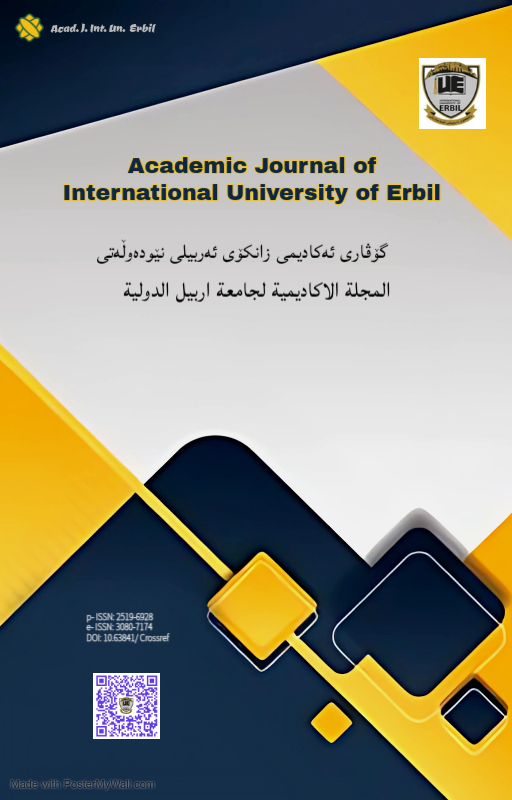Evaluation of B1 gene and G529 repeated element as targets for molecular diagnosis of toxoplasmosis in pregnant and aborted women in Erbil
DOI:
https://doi.org/10.63841/iue12419Keywords:
Key words: Toxoplasma gondii, Toxoplasmosis, PCR, Eliza, B1 gene, G529 repeat elementAbstract
Background and objectives: Toxoplasma gondii is a ubiquitous protozoan parasite that infect one-third of the world’s human population, and diagnosed mainly by serological methods that are impeded by insufficient sensitivity. Therefore, it becomes necessary to rely on either direct discovery of the parasite or DNA detection by polymerase chain reaction (PCR). This study aimed to find out the prevalence of toxoplasmosis among women in Erbil and to organize molecular tools for toxoplasmosis using PCR targeting B1 gene and G529 comparing with Enzyme-linked immunosorbent assay (ELISA). The study also aimed to evaluate placenta versus blood specimens in molecular diagnosis.
Methods: Across sectional study carried out in Erbil city, from November 2015 to September 2016, including convenience samples of 350 women who attended the Maternity Teaching Hospital, and some Primary Health Centers in Erbil city. The subjects involved pregnant women with and without history of abortion, and women at labor room. Peripheral blood samples and were collected. DNA was extracted and the B1 gene and G529 of T. gondii were amplified by PCR.
Results: Out of 350 samples tested, 38(10.9%) and 81(23.1%) were seropositive for anti-toxoplasma IgM and anti-toxoplasma IgG, respectively, and 7(2%) for both IgG and IgM. PCR, targeting B1 gene and G529, revealed positive reactions in 92 (26.3%) and 41 (11.7%), respectively. In 40 placenta specimens collected from abortive and non-abortive women, 1 (5.56 %) and 5 (27.77 %) of abortive women, versus 1 (4.55 %) and 5 (22.73 %) of non-abortive women revealed positive reactions for B1 and G529, respectively. Statistically, there was no significant (P= 0.897, P= 0.533) differences among the studied genes in respect to detect toxoplasmosis in the blood of whether abortive or non-abortive women.
Conclusion: PCR along with serology as a confirmatory test is insisted demand for definitive diagnosis of toxoplasmosis, and PCR targeting G529 being more efficient than B1 gene in the molecular diagnosis. Although not all pregnancies with toxoplasmosis terminated adversely, maternal infection during pregnancy is a serious condition and early diagnosis on time and proper treatment can lead to healthy offspring
References
D. Love, O. C. Kwok, S. K. Verma, P. Jitender, and J. Bellah, “Antibody Prevalence and Isolation of Viable Toxoplasma gondii from Raptors in the Southeastern USA,” vol. 52, no. 3, pp. 653–656, 2015.
Y.-H. Park and H.-W. Nam, “Clinical features and treatment of ocular toxoplasmosis.,” Korean J. Parasitol., vol. 51, no. 4, pp. 393–9, 2013.
K. A. Kerns, S. J. Mish, J. Roberts, and F. Jagdis, “Neuropsychological Profile of Treated Children with Congenital Toxoplasmosis,” no. July, pp. 1079–1089, 2014.
A. A. Aguirre et al., “The One Health Approach to Toxoplasmosis: Epidemiology, Control, and Prevention Strategies,” Ecohealth, vol. 16, no. 2, pp. 378–390, 2019.
T. Nayeri, S. Sarvi, M. Moosazadeh, A. Amouei, Z. Hosseininejad, and A. Daryani, “The global seroprevalence of anti-Toxoplasma gondii antibodies in women who had spontaneous abortion: A systematic review and meta-analysis,” PLoS Negl. Trop. Dis., vol. 14, no. 3, pp. 1–27, 2020.
M. Endris et al., “Seroprevalence and Associated Risk Factors of Toxoplasma gondii in Pregnant Women Attending in Northwest Ethiopia.,” Iran. J. Parasitol., vol. 9, no. 3, pp. 407–14, Sep. 2014.
R. A. Pulido-montoya, G. Acosta-rojas, S. Estrada-martínez, M. D. L. Guerrero-carbajal, O. Liesenfeld, and I. B. García, “ Seroepidemiology of Toxoplasma gondii infection in people applying for medical certificates,” vol. 6, pp. 90–98, 2016.
S. Sroka et al., “Prevalence and Risk Factors of Toxoplasmosis among Pregnant Women in Fortaleza , Northeastern Brazil,” Am. J. Trop. Med. Hyg, vol. 83, no. 3, pp. 528–533, 2010.
F. Robert-Gangneux and M. L. Dardé, “Epidemiology of and diagnostic strategies for toxoplasmosis,” Clin. Microbiol. Rev., vol. 25, no. 2, pp. 264–296, 2012.
Z. Tlamçani, Z. Lemkhenete, and B. E. Lmimouni, “Toxoplasmosis : The value of molecular methods in diagnosis compared to conventional methods,” vol. 3, no. 2, pp. 93–99, 2013.
Q. Liu, Z. Wang, S. Huang, and X. Zhu, “Diagnosis of toxoplasmosis and typing of Toxoplasma gondii,” Parasit. Vectors, vol. 1, pp. 1–14, 2015.
D. Hashoosh and I. Majeed, “Comparison of two assays in the diagnosis of toxoplasmosis: immunological and molecular,” Emhj, vol. 20, no. 1, 2014.
S. S. Azeez and H. M. Alsakee, “Cryptosporidium spp. And rotavirus gastroenteritis and change of incidence after rotavirus vaccination among children in Raparin pediatrics hospital, Erbil, Iraq,” Med. J. Indones., vol. 26, no. 3, pp. 190–197, 2017.
S. Muhie, Y, Keskes, “ toxoplasmosis: emerging and re-emerging zoonosis,” African J. Appl. Microbiol. Res., vol. 3, no. 1, pp. 1–11, 2015.
J. Sroka et al., “Detection and Molecular Characteristics of Toxoplasma gondii DNA in Retail Raw Meat Products in Poland,” Foodborne Pathog. Dis., vol. 16, no. 3, pp. 195–204, 2019.
H. M. Bakre, “Serological tests and polymerase chain reaction for detection of Toxo- plasma gondii infection in women attending for premarital examination,” Zanco J. Med. Sci., vol. 20, no. 3, pp. 1476–1484, 2016.
J. Alghamdi, M. Hussein, and S. Alhabib, “Prevalence and genotyping of Toxoplasma gondii among Saudi pregnant women in Saudi Arabia,” Saudi Pharm. J., vol. 24, no. 6, pp. 645–651, 2016.
S. Rasti et al., “Frequency of Toxoplasma Infection among Pregnant Women and Their Newborn in Kashan, Iran,” pp. 29–32, 2014.
P. R. Torgerson and P. Mastroiacovo, “The global burden of congenital toxoplasmosis: a systematic review,” Bull. World Health Organ., vol. 91, no. 7, pp. 501–508, 2013.
B. Borkakoty, D. Biswas, A. Jakharia, and J. Mahanta, “Seroprevalence of Toxoplasma gondii Among Pregnant Women in Northeast India,” vol. 64, no. October, pp. 24–28, 2016.
S. M. Feustel, M. Meissner, and O. Liesenfeld, “Toxoplasma gondii and the blood-brain barrier.,” Virulence, vol. 3, no. 2, pp. 182–92, Jan. 2012.
M. M. Avelino, D. Campos, J. B. De Parada, and A. M. De Castro, “Risk factors for Toxoplasma gondii infection in women of childbearing age,” Braz. J. Infect. Dis., vol. 8, no. 2, pp. 164–74, 2004.
C. Alvarado-Esquivel, A. Torres-Castorena, O. Liesenfeld, S. Estrada-Martínez, and J. D. Urbina-Álvarez, “High seroprevalence of Toxoplasma gondii infection in a subset of Mexican patients with work accidents and low socioeconomic status,” Parasit. Vectors, vol. 5, no. 1, p. 13, 2012.
A. M. Amosu, N. O. S. Atulomah, M. F. Olanrewaju, T. I. Akintunde, and A. O. Babalola, “Retrospective study of some factors influencing delivery of low birth weight babies in Ibadan , Oyo state , Nigeria,” vol. 6, no. 2, pp. 236–240, 2011.
R. K. Bhaskar et al., “A Case Control Study on Risk Factors Associated with Low Birth Weight Babies in Eastern Nepal,” Int. J. Pediatr., vol. 2015, pp. 1–7, 2015.
C. Negrato and M. Gomes, “Low birth weight: causes and consequences.,” Diabetol. Metab. Syndr., vol. 5, no. 1, p. 49, 2013.
M. H. Elamin, E. M. Al-olayan, S. A. Omer, A. N. Alagaili, and O. B. Mohammed, “Molecular detection and prevalence of Toxoplasma gondii in pregnant women in Sudan,” African J. Microbiol. Res., vol. 6, no. 2, pp. 308–311, 2012.
W. Gelaye, T. Kebede, and A. Hailu, “International Journal of Infectious Diseases High prevalence of anti-toxoplasma antibodies and absence of Toxoplasma gondii infection risk factors among pregnant women attending routine antenatal care in two Hospitals of Addis Ababa ,” Int. J. Infect. Dis., vol. 34, pp. 41–45, 2015.
L. Nimri, H. Pelloux, and L. Elkhatib, “ Detection of Toxoplasma gondii DNA and specific antibodies in high- risk pregnant women,” vol. 71, no. 6, pp. 831–835, 2004.
S. M. Bin Dajem and M. A. Almushait, “Detection of Toxoplasma gondii DNA by PCR in blood samples collected from pregnant saudi women from the aseer region, Saudi Arabia,” Ann. Saudi Med., vol. 32, no. 5, pp. 507–512, 2012.
F. S. Ghasemi, S. Rasti, M. Bandehpour, B. Kazemi, A. Piroozmand, and G. A. Mousavi, “Molecular Diagnosis of Toxoplasma gondii in Aborted Women.,” Jundishapur J Microbiol., vol. 8, no. 1, pp. e15925, 2015.
U. M. Reddy, R. Goldenberg, R. Silver, G. C. S. Smith, R. M. Pauli, J. Gardosi, R. J. Wapner, H. Pinar, M. Grafe, M. Kupferminc, I. Hulthén Varli, J. H. M. Erwich, R. C. Fretts, and M. Willinger. Stillbirth Classification—Developing an International Consensus for Research. Obstetrics & Gynecology, vol. 114, no. 4, pp. 901–14, 2009.












